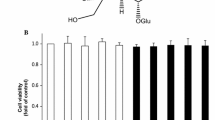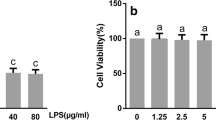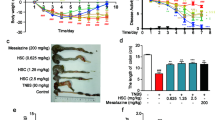Abstract
Intestinal epithelial cells play an important role in the mucosal immune reaction in inflammatory bowel diseases via the expression of inflammatory mediators, such as cyclooxygenase-2 (COX-2) and intercellular adhesion molecule-1 (ICAM-1). Isoliquiritigenin (ISL; 4,2′,4′-trihydroxychalcone) has been shown to exhibit anti-inflammatory properties in murine macrophage cells. In the present study, we evaluated the anti-inflammatory properties of ISL in intestinal epithelial cells and determined its mechanism of action. ISL suppressed the expression of COX-2 and ICAM-1 in tumor necrosis factor-α (TNF-α) stimulated intestinal epithelium HT-29 cells. It also induced peroxisome proliferator-activated receptor-γ (PPARγ) protein expression. Moreover, using a PPARγ antagonist, GW9662, we found that the regulation of COX-2 and ICAM-1 expression by ISL in TNF-α-stimulated HT-29 cells is mediated via PPARγ expression. A signal transduction study revealed that ISL significantly attenuates TNF-α-mediated JNK phosphorylation. ISL-induced ERK1/2 phosphorylation was associated with PPARγ expression. Additionally, both the inhibitory effect on COX-2 and ICAM-1 expression and the induction of PPARγ expression by ISL in TNF-α-stimulated HT-29 cells was abolished by the addition of U0126, a specific ERK1/2 inhibitor. Collectively, ISL-induced PPARγ mediated, at least partially, the suppression of intestinal inflammation. These results suggest that ISL may be beneficial for the treatment of mucosal inflammation.




Similar content being viewed by others
References
Abdalla SI, Sanderson IR, Fitzgerald RC (2005) Effect of inflammation on cyclooxygenase (COX)-2 expression in benign and malignant esophageal cells. Carcinogenesis 26:1627–1633
Are A, Aronsson L, Wang S, Greicius G, Lee YK, Gustafsson JA, Pettersson S, Arulampalam V (2008) Enterococcus faecalis from newborn babies regulate endogenous PPARgamma activity and IL-10 levels in colonic epithelial cells. Proc Natl Acad Sci USA 105:1943–1948
Chinetti-Gbaguidi G, Fruchart JC, Staels B (2005) Role of the PPAR family of nuclear receptors in the regulation of metabolic and cardiovascular homeostasis: new approaches to therapy. Curr Opin Pharmacol 5:177–183
Denmark VK, Mayer L (2013) Current status of monoclonal antibody therapy for the treatment of inflammatory bowel disease: an update. Expert Rev Clin Immunol 9:77–92
Farrell RJ, Peppercorn MA (2002) Ulcerative colitis. Lancet 359:331–340
Finlay BB, Falkow S (1997) Common themes in microbial pathogenicity revisited. Microbiol Mol Boil Rev 61:136–169
Greenhough A, Smartt HJ, Moore AE, Roberts HR, Williams AC, Paraskeva C, Kaidi A (2009) The COX-2/PGE2 pathway: key roles in the hallmarks of cancer and adaptation to the tumour microenvironment. Carcinogenesis 30:377–386
Grishin AV, Wang J, Potoka DA, Hackam DJ, Upperman JS, Boyle P, Zamora R, Ford HR (2006) Lipopolysaccharide induces cyclooxygenase-2 in intestinal epithelium via a noncanonical p38 MAPK pathway. J Immunol 176:580–588
Hobbie S, Chen LM, Davis RJ, Galán JE (1997) Involvement of mitogen-activated protein kinase pathways in the nuclear responses and cytokine production induced by Salmonella typhimurium in cultured intestinal epithelial cells. J Immunol 159:5550–5559
Ikeda Y, Ito M, Matsuu M, Shichijo K, Fukuda E, Nakayama T, Nakashima M, Naito S, Sekine I (2000) Expression of ICAM-1 and acute inflammatory cell infiltration in the early phase of radiation colitis in rats. J Radiat Res 41:279–291
Jiang WY, Seo GS, Kim YC, Sohn DH, Lee SH (2015) PF2405, standardized fraction of Scutellaria baicalensis, ameliorates colitis in vitro and in vivo. Arch Pharm Res 38:1127–1137
Kakegawa H, Matsumoto H, Satoh T (1992) Inhibitory effects of some natural products on the activation of hyaluronidase and their anti-allergic actions. Chem Pharm Bull 40:1439–1442
Kim JY, Park SJ, Yun KJ, Cho YW, Park HJ, Lee KT (2008) Isoliquiritigenin isolated from the roots of Glycyrrhiza uralensis inhibits LPS-induced iNOS and COX-2 expression via the attenuation of NF-kappaB in RAW 264.7 macrophages. Eur J Pharmacol 584:175–184
Lee SH, Kim JY, Seo GS, Kim YC, Sohn DH (2009) Isoliquiritigenin, from Dalbergia odorifera, up-regulates anti-inflammatory heme oxygenase-1 expression in RAW264.7 macrophages. Inflamm Res 58:257–262
Lehmann JM, Moore LB, Smith-Oliver TA, Wilkison WO, Wilson TM, Kliewer SA (1995) An antidiabetic thiazolidinedione is a high affinity ligand for peroxisome proliferator-activated receptor gamma (PPAR gamma). J Biol Chem 270:12953–12956
Levin A, Shibolet O (2008) Infliximab in ulcerative colitis. Biologics 2:379–388
Li JH, Yu JP, Yu HG, Xu XM, Yu LL, Liu J, Luo HS (2005) Melatonin reduces inflammatory injury through inhibiting NF-κB activation in rats with colitis. Mediators Inflamm 4:185–193
Loftus EV Jr (2004) Clinical epidemiology of inflammatory bowel disease: incidence, prevalence, and environmental influences. Gastroenterology 126:1504–1517
Martin H (2010) Role of PPAR-gamma in inflammation. Prospects for therapeutic intervention by food components. Mutat Res 690:57–63
Mohapatra SK, Guri AJ, Climent M, Vives C, Carbo A, Horne WT, Hontecillas R, Bassaganya-Riera J (2010) Immunoregulatory actions of epithelial cell PPAR gamma at the colonic mucosa of mice with experimental inflammatory bowel disease. PLoS One 5:e10215
Nielsen OH, Vainer B, Madsen SM, Seidelin JB, Heegaard NH (2000) Established and emerging biological activity markers of inflammatory bowel disease. Am J Gasteroenterol 95:359–367
Roda G, Sartini A, Zambon E, Calafiore A, Marocchi M, Caponi A, Belluzzi A, Roda E (2010) Intestinal epithelial cells in inflammatory bowel diseases. World J Gastroentrol 16:4264–4271
Roh HC, Yoo DY, Ko SH, Kim YJ, Kim JM (2011) Bacteroides fragilis enterotoxin upregulates intercellular adhesion molecule-1 in endothelial cells via an aldose Reductase-, MAPK-, and NF-κB–dependent pathway, leading to monocyte adhesion to endothelial cells. J Immunol 187:1931–1941
Rousseaux C, Lefebvre B, Dubuquoy L, Lefebvre P, Romano O, Auwerx J, Metzger D, Wahli W, Desvergne B, Naccari GC, Chavatte P, Farce A, Bulois P, Cortot A, Colombel JF, Desreumaux P (2005) Intestinal antiinflammatory effect of 5-aminosalicylic acid is dependent on peroxisome proliferator-activated receptor-gamma. J Exp Med 201:1205–1215
Sans M, Panés J, Ardite E, Elizalde JI, Arce Y, Elena M, Palacín A, Fernández-Checa JC, Anderson DC, Lobb R, Piqué JM (1999) VCAM-1 and ICAM-1 mediate leukocyte-endothelial cell adhesion in rat experimental colitis. Gastroenterology 116:874–883
Sarraf P, Mueller E, Jones D, King FJ, DeAngelo DJ, Patridge JB, Holden SA, Chen LB, Singer S, Fletcher C, Spiegelman BM (1998) Differentiation and reversal of malignant changes in colon cancer through PPARgamma. Nat Med 4:1046–1052
Servidei T, Morosetti R, Ferlini C, Cusano G, Scambia G, Mastrangelo R, Koeffler HP (2004) The cellular response to PPARgamma ligands is related to the phenotype of neuroblastoma cell lines. Oncol Res 14:345–354
Tawata M, Aida K, Noguchi T, Ozaki Y, Kume S, Sasaki H, Chin M, Onaya T (1992) Anti-platelet action of isoliquiritigenin, an aldose reductase inhibitor in licorice. Eur J Pharmacol 212:87–92
Wang D, DuBois RN (2010) The role of COX-2 in intestinal inflammation and colorectal cancer. Oncogene 29:781–788
Weaver SA, Russo MP, Wright KL, Kolios G, Jobin C, Robertson DA, Ward SG (2001) Regulatory role of phosphatidylinositol 3-kinase on TNF-alpha-induced cyclooxygenase 2 expression in colonic epithelial cells. Gastroenterology 120:1117–1127
Wright KL, Weaver SA, Patel K, Coopman K, Feeney M, Kolios G, Robertson DA, Ward SG (2004) Differential regulation of prostaglandin E biosynthesis by interferon-γ in colonic epithelial cells. Br J Pharmacol 141:1091–1097
Yomogida S, Hua J, Sakamoto K, Nagaoka I (2008) Glucosamine suppresses interleukin-8 production and ICAM-1 expression by TNF-alpha-stimulated human colonic epithelial HT-29 cells. Int J Mol Med 22:205–211
Yu SM, Kuo SC (1995) Vasorelaxant effect of isoliquiritigenin, a novel soluble guanylate cyclase activator, in rat aorta. Br J Pharmacol 114:1587–1594
Yu Y, Sitaraman S, Gewirtz AT (2004) Intestinal epithelial cell regulation of mucosal inflammation. Immunol Res 29:55–68
Acknowledgments
This study was supported by a Grant from Wonkwang University for Prof. Sung Hee Lee (2015).
Author information
Authors and Affiliations
Corresponding author
Ethics declarations
Conflict of interest
The authors declare that they have no conflict of interest.
Rights and permissions
About this article
Cite this article
Jin, X.Y., Sohn, D.H. & Lee, S.H. Isoliquiritigenin suppresses tumor necrosis factor-α-induced inflammation via peroxisome proliferator-activated receptor-γ in intestinal epithelial cells. Arch. Pharm. Res. 39, 1465–1471 (2016). https://doi.org/10.1007/s12272-016-0805-x
Received:
Accepted:
Published:
Issue Date:
DOI: https://doi.org/10.1007/s12272-016-0805-x




